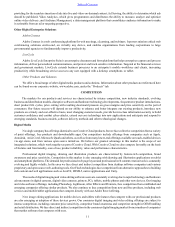Adobe 2013 Annual Report Download - page 20
Download and view the complete annual report
Please find page 20 of the 2013 Adobe annual report below. You can navigate through the pages in the report by either clicking on the pages listed below, or by using the keyword search tool below to find specific information within the annual report.
20
• we may incur costs at a higher than forecasted rate as we expand our cloud operations.
Subscription offerings create risks related to the timing of revenue recognition.
Although the subscription model is designed to increase the number of customers who purchase our products and services
and create a recurring revenue stream that is more predictable, it creates certain risks related to the timing of revenue recognition
and potential reductions in cash flows.
A portion of the subscription-based revenue we report each quarter results from the recognition of deferred revenue relating
to subscription agreements entered into during previous quarters. A decline in new or renewed subscriptions in any period may
not be immediately reflected in our reported financial results for that period, but may result in a decline in our revenue in future
quarters. If we were to experience significant downturns in subscription sales and renewal rates, our reported financial results
might not reflect such downturns until future periods. Our subscription model could also make it difficult for us to rapidly increase
our revenues from subscription- or SaaS-based services through additional sales in any period, as revenue from new customers
will be recognized over the applicable subscription term. Further, any increases in sales under our subscription sales model could
result in decreased revenues over the short term if they are offset by a decline in sales from perpetual license customers.
Additionally, in connection with our sales efforts to enterprise customers and our introduction of ETLAs, a number of
factors could affect our revenues, including longer than expected sales and implementation cycles, potential deferral of revenue
due to multiple-element revenue arrangements and alternate licensing arrangements. If any of our assumptions about revenue from
our new businesses or our addition of a subscription-based model prove incorrect, our actual results may vary materially from
those anticipated, estimated or projected.
We may be unable to predict subscription renewal or upgrade rates and the impact these rates may have on our future revenue
and operating results.
The SaaS business model we utilize in our Adobe Marketing Cloud offerings typically involves selling services on a
subscription basis pursuant to service agreements that are generally one to three years in length. Our individual Creative Cloud
subscription agreements are generally month to month or one year in length, ETLAs for our digital media products and services
are generally three years in length, and subscription agreements for other products and services may provide for shorter or longer
terms. Although many of our service and subscription agreements contain automatic renewal terms, our customers have no
obligation to renew their subscriptions for our services after the expiration of their initial subscription period, and some customers
elect not to renew. We cannot provide assurance that these subscriptions will be renewed at the same or higher level of service,
for the same number of seats or for the same duration of time, if at all. Moreover, under certain circumstances, some of our
customers have the right to cancel their service agreements prior to the expiration of the terms of their agreements. We cannot be
assured that we will be able to accurately predict future customer renewal rates. Our customers' renewal rates may decline or
fluctuate as a result of a number of factors, including their satisfaction or dissatisfaction with our services, the prices of our services,
the perceived information security of our systems and services, the prices of services offered by our competitors, mergers and
acquisitions affecting our customer base, reductions in our customers' spending levels, or declines in customer activity as a result
of economic downturns or uncertainty in financial markets. If our customers do not renew their subscriptions for our services or
if they renew on less favorable terms to us, our revenues may decline.
Our future growth is also affected by our ability to sell additional features and services to our current customers, which
depends on a number of factors, including customers' satisfaction with our products and services, the prices of our offerings and
general economic conditions. If our efforts to cross-sell and upsell to our customers are unsuccessful, the rate at which our business
grows might decline.
Security vulnerabilities in our products and systems could lead to reduced revenues or to liability claims.
Maintaining the security of our products, computers and networks is a critical issue for us and our customers. Security
researchers, criminal hackers and other third parties regularly develop new techniques to penetrate computer and network security
measures and have in the past managed to penetrate certain of our systems and misused certain of our systems and software in
order to access our end users’ authentication and payment information. In addition, cyber-attackers also develop and deploy viruses,
worms and other malicious software programs, some of which may be specifically designed to attack our products, systems,
computers or networks. Sophisticated hardware and operating system software and applications that we produce or procure from
third parties may contain defects in design or manufacture, including bugs and other problems that could unexpectedly compromise
the security of the system. The costs to us to eliminate or alleviate cyber or other security problems, bugs, viruses, worms, malicious
software programs and security vulnerabilities are significant, and our efforts to address these problems may not be successful
and could result in interruptions, delays, cessation of service and loss of existing or potential customers that may impede our sales,
manufacturing, distribution or other critical functions, as well as potential liability to the company.
Table of Contents
























